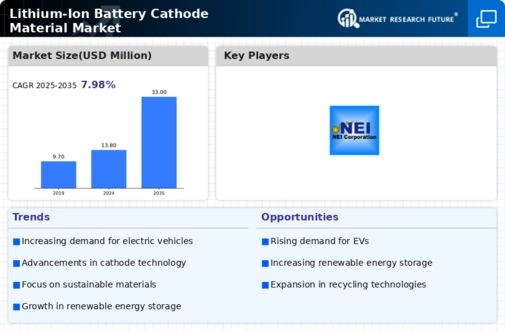Market Trends
Key Emerging Trends in the Lithium Ion Battery Cathode Material Market
The Lithium-Ion Battery Cathode Material Market is undergoing significant transformations, reflecting the dynamic landscape of the energy storage sector. The surge in global interest and adoption of electric vehicles is a primary driver for the lithium-ion battery cathode material market. Cathode materials, particularly those based on nickel, cobalt, and manganese, are in high demand as automakers attempt to improve EV battery energy density and performance. High-nickel cathode chemistries, such as NMC (Nickel Manganese Cobalt) and NCA (Nickel Cobalt Aluminum), are gaining popularity in the industry. High-nickel cathodes have a greater energy density, a longer cycle life, and better overall performance, making them critical for the evolution of electric vehicle technology. Growing environmental and ethical concerns regarding cobalt mining have motivated a determined push to minimize or remove cobalt presence in cathode materials. As the industry explores more sustainable and ethical battery solutions, cathode compositions with reduced cobalt concentration, or cobalt-free alternatives, are gaining appeal. Lithium-iron-phosphate cathodes are making a comeback, especially in applications where safety and cost-effectiveness are critical. LFP cathodes are becoming increasingly used in electric buses, stationary energy storage systems, and other applications where safety, performance, and cost must be balanced. In order to boost the energy density of lithium-ion batteries, high-capacity materials such as silicon are being included into cathode compositions. The potential of silicon-based anodes to considerably improve the total energy storage capacity of lithium-ion batteries is being investigated. Aside from electric cars, lithium-ion battery cathode materials are in high demand in portable devices and fixed energy storage applications. Smartphones, laptops, and grid-level energy storage solutions help to diversify the industry and give new growth prospects. The Asia-Pacific area, notably China and South Korea, continues to be the core of lithium-ion battery manufacturing and usage. Shifts towards higher nickel content cathodes, such as NCM and NCA, aim to enhance energy density and reduce dependency on cobalt, a material associated with ethical and supply chain concerns. Technological advancements in cathode chemistry contribute to the evolution of lithium-ion batteries and their applications. Intense competition among key players in the lithium-ion battery cathode material market drives innovation and cost-effectiveness. Companies strive to gain a competitive edge by developing cathode materials with superior performance characteristics and cost-efficiency.




Leave a Comment